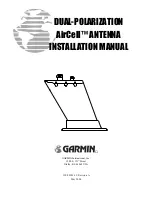Summary of Contents for AN6-098P
Page 6: ... Contents vi 1037312 0001 Revision B ...
Page 10: ... Tables x 1037312 0001 Revision B ...
Page 22: ...Chapter 1 Overview 6 1037312 0001 Revision B ...
Page 46: ...Chapter 3 Assembling the antenna 30 1037312 0001 Revision B ...
Page 58: ...Chapter 4 Installing a J type radio assembly 42 1037312 0001 Revision B ...
Page 72: ...Chapter 6 Cabling and connections 56 1037312 0001 Revision B ...
Page 92: ...Chapter 7 Pointing the antenna 76 1037312 0001 Revision B ...
Page 94: ... Acronyms and abbreviations 78 1037312 0001 Revision B ...



































